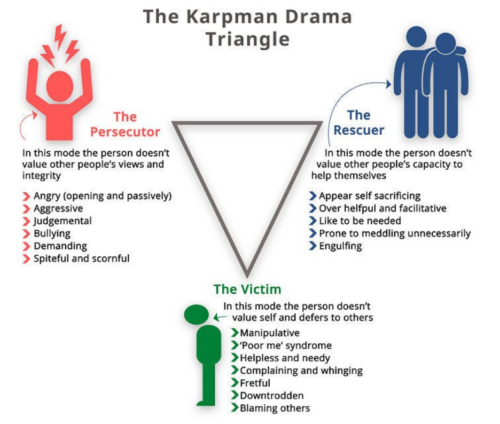
The One or The Dozen
February 11, 2025
Dividing the Nest Egg: What You Need to Know About Retirement Plans and Divorce
May 27, 2025THE TRIANGLE TRAP
Some roles feel strangely satisfying—like putting on your comfiest old hoodie. You slip into them without even realizing it. You’re driving with a 12-year and have to slam on the brakes. Instantly your arm shoots out in front of your child because Mama Bear is going to be sure he’s safe—seat belt notwithstanding. But some roles are a trap.
The Karpman Drama Triangle provides a fascinating framework for understanding dysfunctional conflict. Therefore it’s a trap where no one wins. In the midst of a divorce or conflict, it’s the last place you want to be.
The Triangle
The Drama Triangle has three roles: Victim, Persecutor, and Rescuer. People can shift between these roles—particularly in the course of a prolonged conflict. The Victim feels helpless and mistreated (“Why are you doing this to me? Why is this happening to me?”), the Persecutor dishes out blame or control (“This is all your fault!”), and the Rescuer swoops in to fix or soothe, often at their own expense (“Let me handle this for you…”).
It’s a familiar dance in high-stress situations. Divorce? It’s practically a stage set for the triangle.
Spouse A is unfairly treated or even attacked by Spouse B, the Persecutor. Therefore spouse A is clearly the Victim. Spouse B feels guilty, apologizes and then moves out of his/her Persecutor role into Rescuer, accommodating and compensating the Victim. But sometimes taking responsibility and apologizing isn’t enough for the Victim who relishes the role and makes sure others know all about his/her status as Victim—and some harm is so acute, it can seem justified. Nevertheless by choosing over time to stay in the Victim role, Spouse A has actually now moved into the Persecutor role, unintentionally flipping Spouse B into the Victim who continues to be vilified and blamed even after apologizing and making amends. It is a sick cycle that can repeat itself over and over.
It’s exhausting. It’s reactive. And it’s not working.

The Trap
It feels like action—but it’s really reaction. Each role keeps you stuck in blame, martyrdom, or power plays. You spin in the triangle trying to get relief, but end up reinforcing the very dynamic you want to escape. And guess what? Kids pick up on it. They can get pulled in too—rescuing, blaming, or feeling helpless.
Getting Out of the Triangle
Here’s the shift: move from Victim to Creator[i]
You are not helpless. You get to choose how you show up.
Victim to Creator:
- Instead of: “Why is this happening to me?” or “How could you do that to me?”
- Try: “I don’t ever want to be there again. What’s mine to own, and what can I do differently? ”
Persecutor to Challenger:
- Instead of: “You always ruin everything.”
- Try: “This isn’t working for me. Let’s find a better way.”
Rescuer to Coach:
- Instead of: “Let me fix this for you.”
- Try: “What support would actually help you right now?”
How to Shift and Say Goodbye to the Triangle Trap. 
- Notice the role you’re in. Are you blaming? Feeling helpless? Trying to rescue? Name it.
- Call out the pattern. “I think we’re stuck in a triangle here. I’m tired of the spin cycle. I realize I’ve been in a Victim/Rescuer/Persecutor role and I’m going to change that.”
- Take radical responsibility. What’s one step you can take that doesn’t rely on the other person changing?
- Get curious, not critical. Ask: “What do I really want right now? What need am I trying to meet?”
- Step into Creator mode. Choose a response that reflects your values—not your emotional reflexes.
How does this work in a real situation?
Let’s say your co-parent shows up late—again—for the kid exchange. You start to seethe. “He does this on purpose. He knows it drives me crazy.” (Victim + Persecutor mode loading…) Therefore you think about texting a snarky comment or venting to a friend. Instead you pause. Take a breath. You name the story in your head. “I’m claiming a Victim role and viewing my co-parent as the Persecutor.”
As a result you check out of the trap: “I’m not a Victim and my co-parent is not the Persecutor. Ask yourself: “What do I want here?” You realize you want reliability—not revenge. So you text: “I noticed you were late today. This keeps happening, and it’s creating tension. I’d like to talk about how we can make this smoother for everyone.”
You didn’t rescue. Didn’t blame. Didn’t stew. You stepped into Creator mode. That’s power. That’s progress.
In Reality
The triangle doesn’t just dissolve overnight. It takes time, awareness, and new tools. But every time you recognize and exit the triangle, you build something better—respect, clarity, stability. And that’s good for everyone, especially your kids.
[i] Emerald, David (2016). The Power of TED*(3rd ed.). Polaris Publishing. pp. 1–138. ISBN 978-09968718-0-8.





